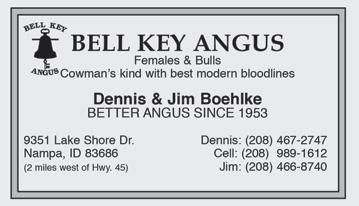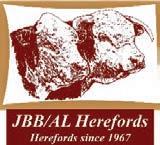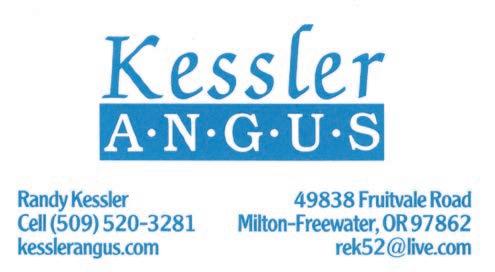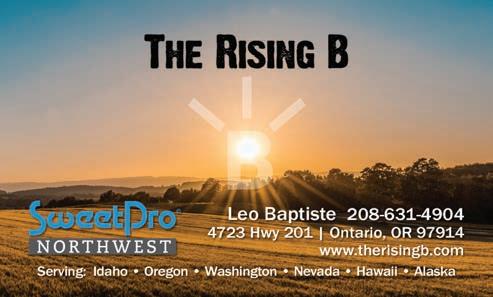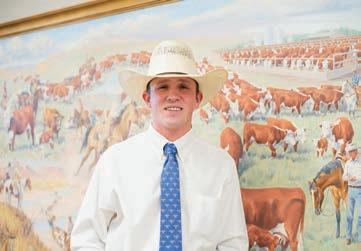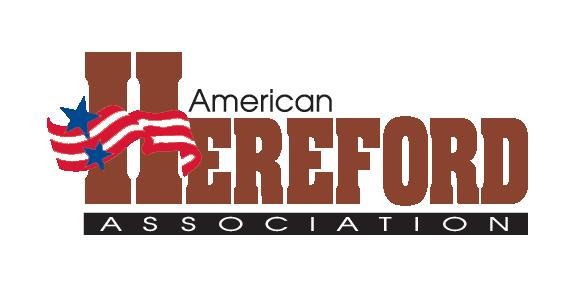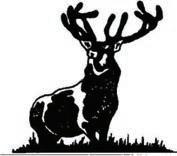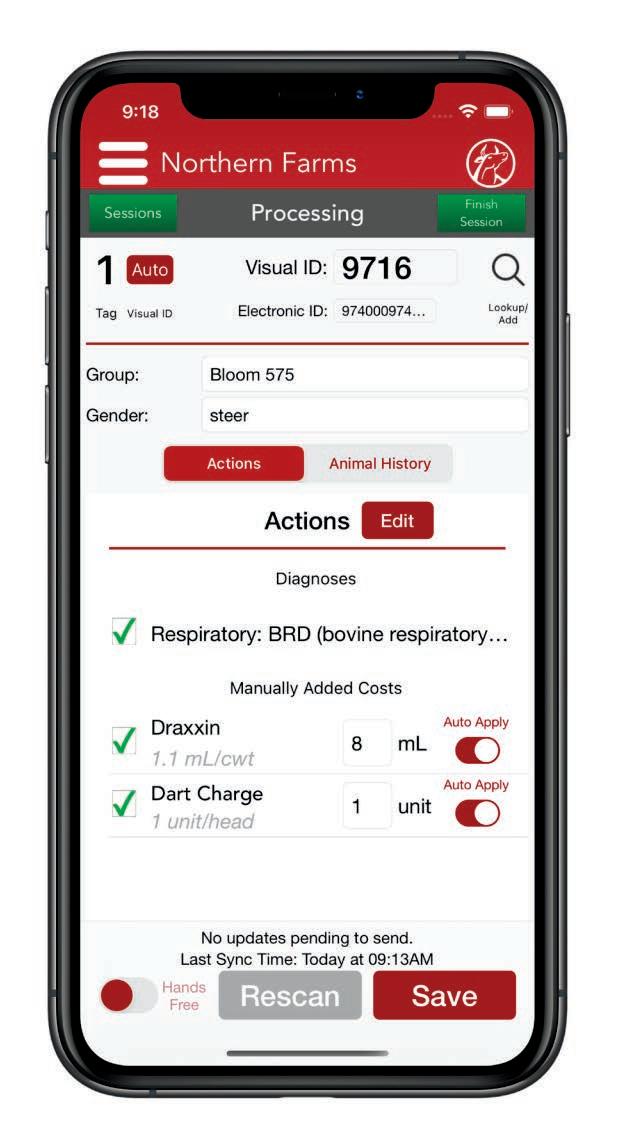
















PRESIDENT Kim Brackett (Kimberly) 208-308-1952
PRESIDENT-ELECT
Jerry Wroten (Wilder) 208-831-7339
VICE PRESIDENT
Spencer Black (Almo) 208-647-8130
PAST PRESIDENT Mark Pratt ...........(Blackfoot) 208-681-6597
TREASURER
Cody Hendrix (Rigby) 208-360-9693
FEEDER COUNCIL CHAIR
Shawna Gill (Grandview) 208-850-9076
PUREBRED COUNCIL CHAIR
Val Carter (Pingree) 208-390-4811
COW-CALF COUNCIL CHAIR
Brayden Eliason (Holbrook) 208-705-2541
CATTLEWOMEN COUNCIL CHAIR
Maggie Malson (Parma) 208-739-2265
DISTRICT 1 REPRESENTATIVES
Eric Wittman (Lapwai) 208-790-5344
Casey Scott...............(Clarkston) 208-431-3024
DISTRICT 2 REPRESENTATIVES
Lori Ireland (Mountain Home) 208-866-0112
Royce Schwenkfelder (Cambridge) 208-550-2200
DISTRICT 3 REPRESENTATIVES
Eugene Matthews (Oakley) 208-431-3260
Jesse Human (Jerome) 208-358-1277
DISTRICT 4 REPRESENTATIVES
Ryan Steele (Idaho Falls) 208-390-5765 Chris Kirby (Salmon) 208-223-2258
DISTRICT 5 REPRESENTATIVES
Roscoe Lake (Blackfoot) 208-604-3650 Arnold Callison (Blackfoot) 208-681-8440
ALLIED INDUSTRY REPRESENTATIVE
Kody Dee Williams.....(Fruitland) 509-948-6430
DIRECTORS AT LARGE
Robert Oxarango (Emmett) 208-431-0777
Adrian Meyer (Grand View) 208-509-1892
CATTLEWOMEN BOARD REPRESENTATIVE Tay Brackett (Filer) 208-866-4967
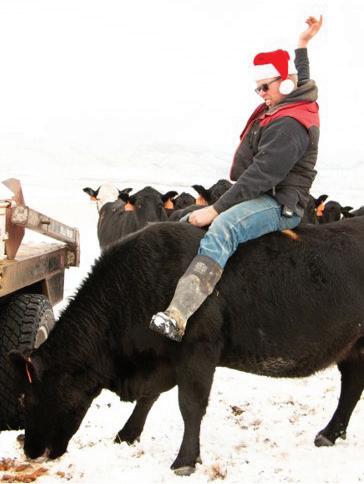
EXECUTIVE
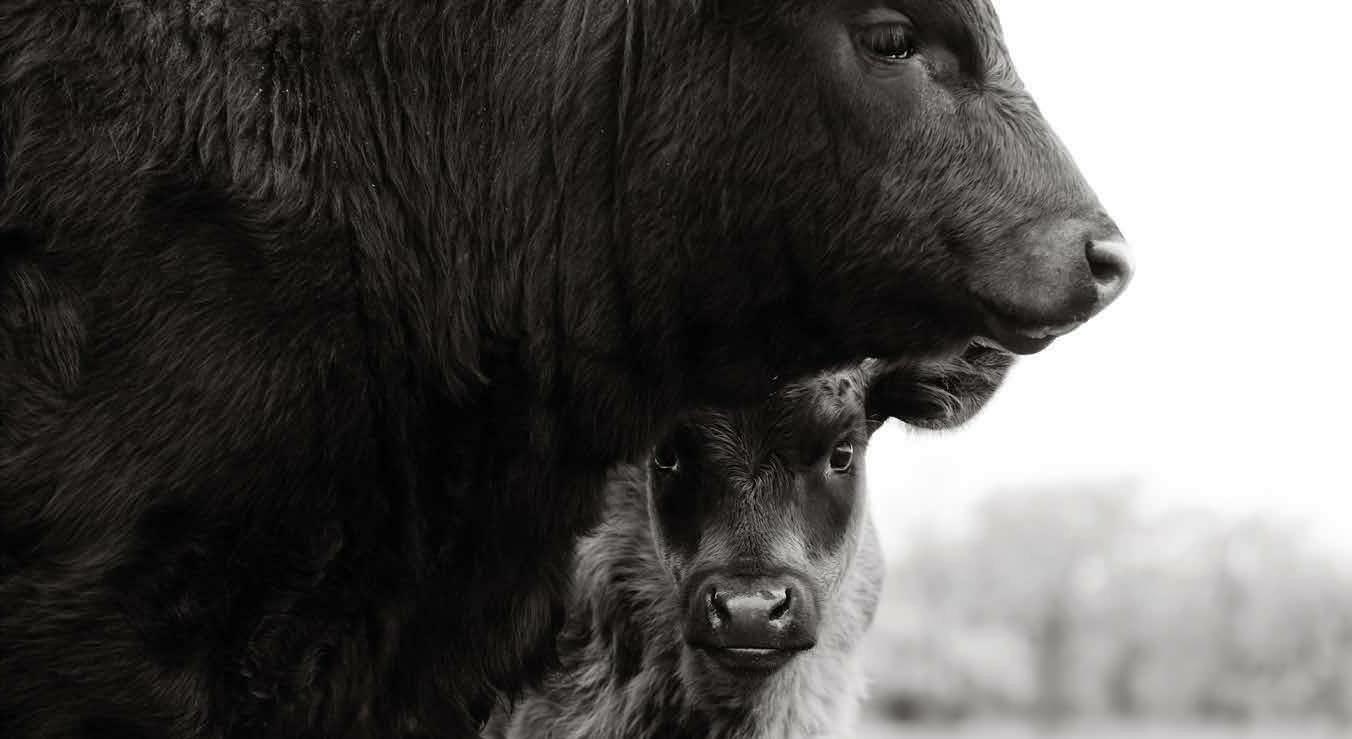



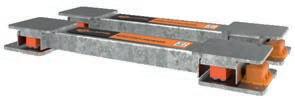
Iam excited and honored to serve as your ICA President this year. ICA has been a part of my life for such a long time and, yet, I am still surprised to find myself in this position. I moved to Idaho after my husband, Ira, and I were married and one of the first events we attended together was ICA’s annual convention. It was at that convention when I began to meet so many of the wonderful people that comprise the heart of the Idaho cattle industry.
Over the years, those same people gave me a chance to be involved in ICA. They guided, supported and encouraged me in different ways, large and small. Most importantly, they served as examples of what great leadership looks like. I watched those leaders work to gather input, help build a consensus and take action on membership policies. I saw the sacrifices they made as they volunteered their time and resources to ICA. As I move into the role of ICA President, I continually remind myself of the many talented leaders that have come before me, and I am humbled to follow in their footsteps.
A little about me, I grew up on my parent’s ranch in Wyoming and moved to Three Creek, Idaho af-
 BY KIM BRACKETT ICA President
BY KIM BRACKETT ICA President

ter marrying Ira. We are raising our four children on his family’s ranch. Our two oldest boys are both in college, our daughter is in high school, and our youngest son is finishing the last of his middle school years (hallelujah!). We run a cow/calf and stocker operation that keeps all of us busy. Most of our time is spent chasing kids, calves, horses or dogs and, honestly, I wouldn’t have it any other way.
Perhaps the most important lesson I learned during those first years of my ICA membership is that the success of our association is built upon a strong foundation of grassroots involvement. The active participation of our members over the course of many years has built ICA into a policy association that has a solid working relationship with various government agencies and is well-respected by our state legislature. However, grassroots organizations are only as strong as their membership. Volunteerism and association membership is on the decline in our society, yet ICA’s work never ends. We have our perennial issues: wolves, sage grouse, state politics and agency relationships. In addition, there are emerging issues such as, increased recreation on state and federal lands. We recognize it is challenging to find the time to attend cattle association meetings; life and work pressures always tend to come first. I encourage you to find a way that you can engage at either a local or state level, ICA needs your input and your involvement as we continue to tackle the issues that are most critical to the future success of Idaho’s cattle industry.
ICA’s new Board President takes the reins
Grassroots organizations are only as strong as their membership.
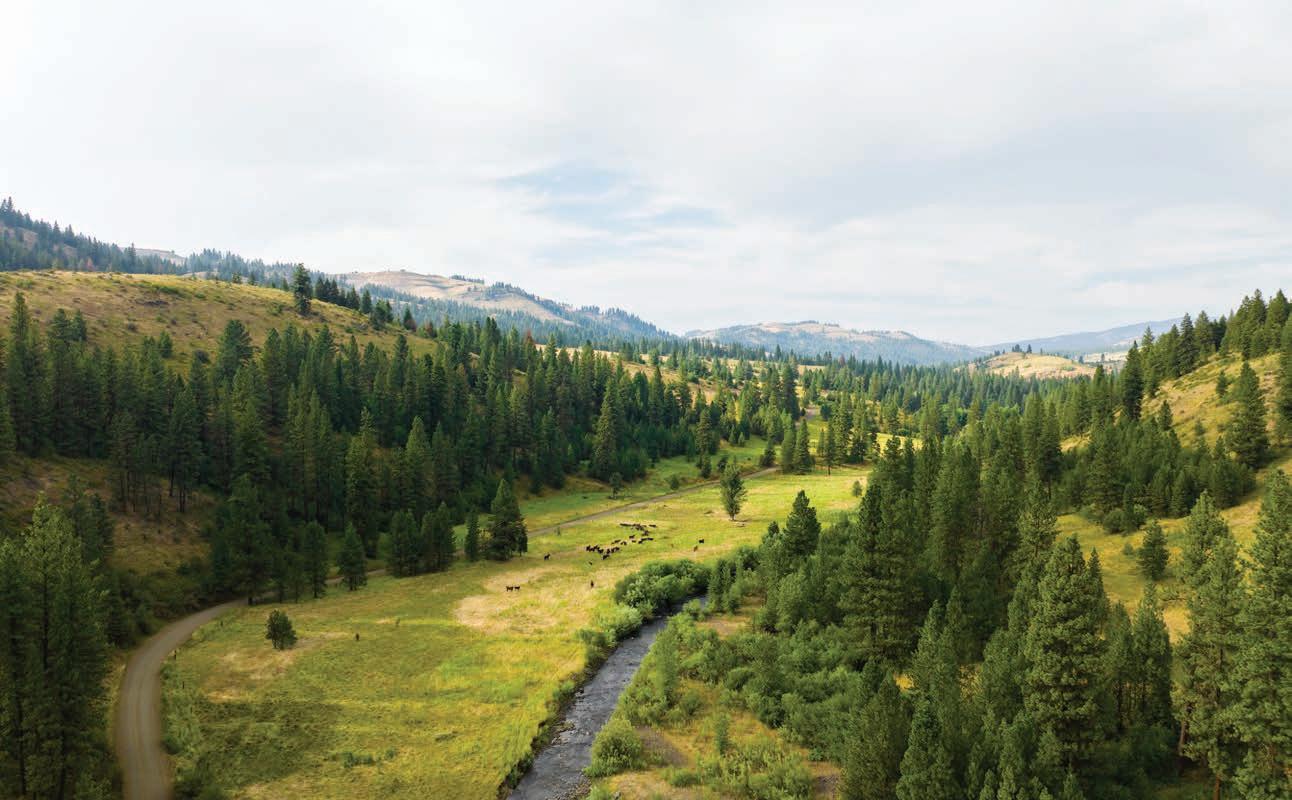

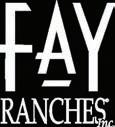
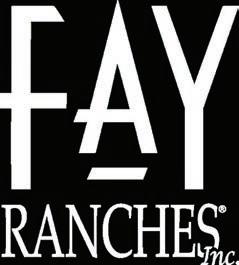
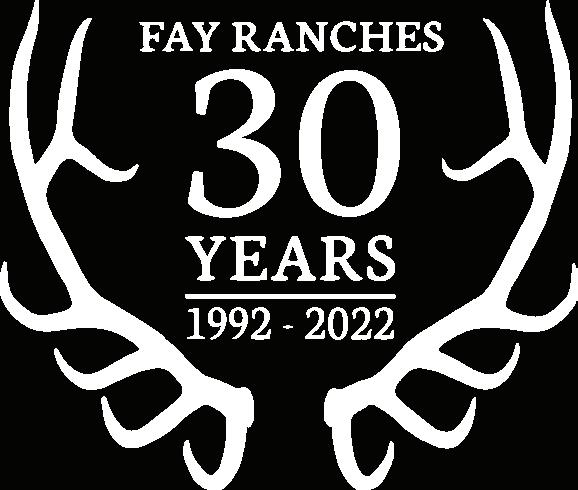
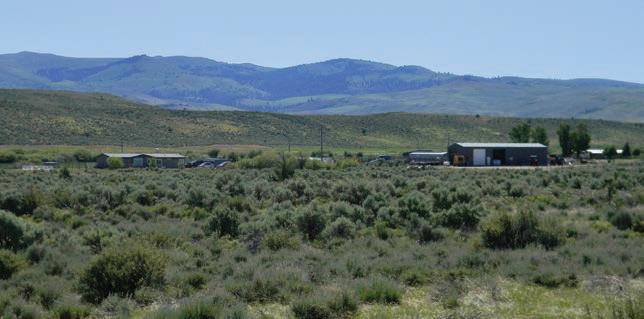
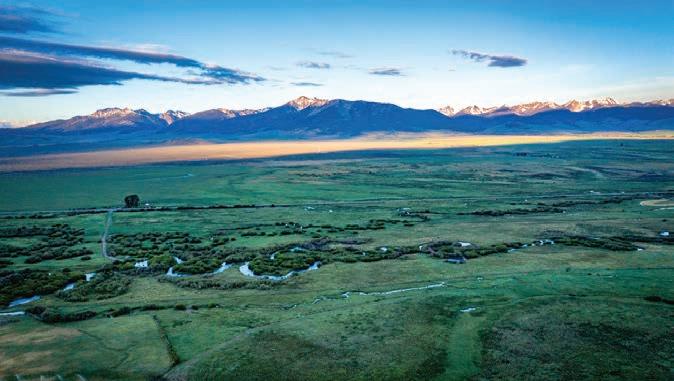
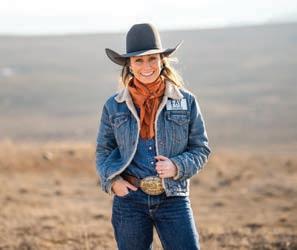
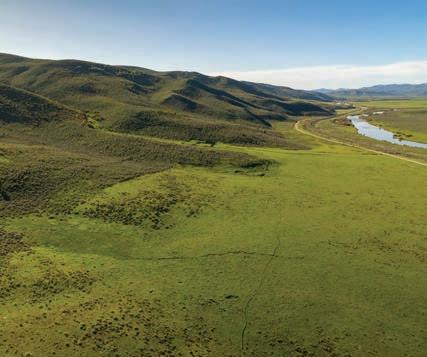


The holiday season is upon us! It’s the time of year where we tend to highlight what we are thankful for, as well as look forward to the gifts of a new year. In this message, I’ve decided to write my list of Christmas wishes for our industry. Maybe I should try to win the next Powerball Jackpot instead, but we can wish, right?
BY CAMERON MULRONY ICA Executive Vice Presidentsage grouse work, who has been regulated? The obvious answer is industry! We need habitat mitigation, who do they call on? Industry! We need to stop the largest threats (fire and invasives) that are affecting habitat, who can make a change? Industry! I have yet to see those NGO’s who are willing to input on regulation for our industry (again, a secondary threat), pick up a shovel or grab a hose to limit fire spread. We see time and again, it’s our producers giving their time and resources to protect the range, to work to protect the bird, and further protect the Idaho cattle industry. As an add on to this wish example, I’d venture to say that most producers are willing to self-regulate on behalf of clean water and green grass. However, layers of policy and regulation at times won’t even allow our producers to make small changes that we know can provide a positive impact on the land.
1My first wish is to allow our industry to operate freely and without unnecessary regulation. I’ll admit, this is a large gift that even Santa may have a tough time finding. Most of our regulations were initially put in place, once upon a time, to “help” or protect something specific. Maybe it was us, maybe it was another resource, maybe it was a particular group’s agenda. The problem that I see continually is that we are being regulated right out of business: death by a thousand cuts. It’s painful and it’s slow. For example:
Sage Grouse amendments: These are now lengthy, and downright painful. The original intent was to protect the bird! Ok, I can see & agree that we don’t want species to become extinct. However, improper grazing has been determined to be a secondary threat. My question is, over the decades of
My second wish is the gift of unity. I would love to identify a specific topic that our industry is unified on, so that we can push forward and help all the members of the cattle industry. This does not mean I am looking for world peace. I would like to see honest, and frankly hard, conversations throughout all aspects of our industry to find workable solutions to the issue. Our cattle industry family often has discourse on many ideas and often I find myself advocating against issues. I want to find the issue we can all rally behind and push through to ease the burden of producers without conflicting messaging coming from inside the industry itself. For example:
Product of the USA labeling: I think we can all agree that the consumer wants to know the history of their food. Many in our industry have taken advantage of this by creating boutique style branded programs, complete with sideboards identifying what their product encompasses. However, on the flip side, producers are also looking across the fence and wanting an implemented “fairness” clause so

they too can realize the pricing benefit, without the history of building a brand and creating their niche. At the end of the day, let’s have these discussions in our house and get it in order and not air our dirty laundry in front of the world.
Do I want an informed consumer to purchase high quality protein produced here in the United States and benefiting the Idaho cattle industry? Absolutely! Do I want a regulation imposed on all members of our industry to require management practices, tracking of cattle, etc.? NO. …But let’s get this sorted on our end and find measures that allow us to operate how we as producers see best for our operation.
3Next on my list, is that I want producers to be viewed as credible industry experts—specif-
comment that ‘without a Ph D. or Masters degree, a certain group of people (reviewing an issue) would not view me as a credible source on the cattle industry’. I can tell you the most credible people are the boots on the ground- the folks that work in the field, day in and day out, regardless of their formal education.

rifle with a synthetic stock, he still takes a nice buck annually. The neighbor is an expert on his range: his knowledge, regardless of his degree or tools, has proven he knows the land and animals that inhabit it. He should be considered a credible hunting source, just as much as the first member in this example.
My example here is not cattle specific, just animals in general. We all know someone who is an avid hunter—has all the cool gadgets, the best of the best gear, plus the time & ambition to scout, stalk and pursue his game. He is probably one of the most successful of hunters. We also know his ‘cousin’, who has also purchased all the bells and whistles, hunts heavily, but has limited successes. Lastly, we know the neighbor on the ranch where they both
Now, after reading these wishes, you may be inclined to think maybe I should have asked for a genie in a bottle or a unicorn instead. While it may be difficult to view these wishes as achievable in the short term, I really believe that with support they could come to fruition. With that in mind, my true Christmas wish is that each and every reader of this article get involved this year. Encourage your friends to get involved. January will be here soon, and
It’s that time again—you know, the most wonderful time of the year. Personally, I do consider it among the most wonderful times of the year and find myself getting caught up in the festive air. However, while December brings the many joys of Christmastime, I recognize that the month also ushers in some unpleasantries. While a warm atmosphere full of lights and decorations typically awaits indoors, the air outside is a bit different and serves as a marked contrast. In my neck of the woods, Christmastime and the weeks immediately follow-
BY KAREN WILLIAMS ICA Natural Resources Policy Director
ing are typically the coldest and snowiest of the year. Pastures are blanketed with snow which means the feed truck must be fired up again. The enslavement to the cows’ daily feeding schedule begins which is immediately followed up with the many stresses of calving season and its preparations. The stackyard full of hay begins to dwindle all too quickly and the drudgeries of working in cold and blustery weather add up. Likely, just reading about this makes you apt to grumble. The contrasts between the frustrations associated with cold weather and the feelings of joy and appreciation of the season are strong yet provide much needed balance to our lives. Too much of a good thing creates apathy and dulled senses, while too much of a bad thing is just, well, bad.
I frustrate my kids by not letting them listen to Christmas music before Thanksgiving, but then it’s full on only Christmas music on my playlist for a month. By my way of thinking, if we listened to it early, we would be tired of it before Christmas even arrived. Balance. Similarly, there are few things I love more than the feelings brought by the Christmas tree, lights, and a house fully decorated for the holidays. But when the season is over and all the excess is put away, the cleared-out spaces feel nice. Balance.
Life in the cattle industry is full of juxtapositions that create balance. We struggle through the hardships brought on by an unstable industry reliant on too many outside factors, but we experience joys of life and nature that few others do because of our lifestyle. Balance.
The recent elections, just behind us though still unsettled, certainly provided reason to feel out of balance. Many of us hoped for sweeping changes across the nation that did not happen. I have heard some pundits talk about how divided branches of the federal government create balance. More realistically, it is
How life in the cattle industry presents a series of self-righting stabilities
While we are likely to continue to feel frustrated by illconceived proposals and stonewalling in Washington for at least the next two years, we can find some relief in the fact that we are well represented within our own state by lawmakers and elected officials who have roots in the cattle business and continue to protect our industry.
gridlock. But oftentimes gridlock is preferrable to united forces whose perspective is contrary to your own. Therein lies the balance—some years we are able to achieve victories for our industry while at other times, we spend the majority of our time playing defense against ill-conceived laws and regulations that would harm our ability to pursue our way of life and produce food. While we are likely to continue to feel frustrated by ill-conceived proposals and stonewalling in Washington for at least the next two years, we can find some relief in the fact that we are well represented within our own state by lawmakers and elected officials who have roots in the cattle business and continue to protect our industry. Balance.

The road ahead for our industry is as full of uncertainties as it ever has been. Yet the challenges create opportunities which can bring balance to our wary souls. As tired as we may be of hearing about climate change and of those who errantly blame our industry, the issue may bring new and unique opportunities. Already, it has led to discussions which have given us the opportunity to exhibit the benefit of cattle in tackling the potential effects of living in an ever-changing and undependable climate. The benefits of livestock grazing to wildfire fuels control, soil heath, and carbon sequestration are starting to become discovered by those outside our industry. It is incumbent upon us to build upon these thoughts and tell the positive story of our industry—to provide balance to the discussion and let the public and policymakers know of the balance we promote to the ecosystem. Frustrating theories and outlandish proposals can lead to improved dialogue, proof in the benefits of our industry, and new partnerships. Balance.

As we continue to tackle issues thrown at our industry, and as you trudge through the chores of life, look for and find appreciation in the balance. Here’s wishing that the reason for the season gives you opportunity to look at life with a fresh perspective and renewed outlook. May you find balance in the joys and in the struggles of your life.
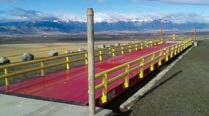
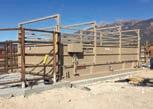
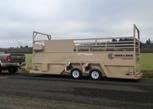
If anything can be said for the weather this fall, it’s been lack of consistency. It started hot and dry and then turned very cold with snow right at the annual convention. It feels like that’s the same story for the world we live in. The lack of consistency in obtaining supplies needed for our business, or the price of those supplies has been hard to keep a handle on. The markets have been tough too, with more volatile reactions to what would normally be considered small triggers.
The cost of doing business has increased tenfold with the price of fuel more than double a year ago, the cost of interest feeling almost that much higher as well. The price of hay and fertilizer have followed almost as strong, and labor probably would if you could find somebody to show up to work every day. Unfortunately, the price of calves hasn’t increased by the same amount, although I would hope that all producers are selling their cattle for more now than they did a year ago.
When looking at the ranches throughout Idaho the main consistency that I see, is that our people in the industry are still the same. We still have the same great ranchers that we always have. There are pockets around the state where some land ownership has changed but by and large we are still working with the same sales teams for our supplies, the same buyers for our
BY CODY HENDRIX ICA Treasurercalves, and the same people are still producing beef. And the reason we are still the ones producing beef is because we have been good managers of our business over time.
I had a conversation last week that started with the comment “it feels like we have the perfect storm in the ranching industry right now. We have a drought, inputs are higher, feed is expensive, we have less cows on the ranch, and our calves are not bringing enough to make the ends meet.” I’ve thought about this, and especially in relation to the people that are managing the ranches we live on. We have been through tough years before. And we have all done what it takes to get through.
The difference is that most of those times were because of low calf prices, not high calf prices. It would be easy to sit back and look at a calf check that is bigger than last year and think “this is going to be a good year”. But that complacency is what can make a ranch go broke. This is the time to really ‘sharpen the pencil’ and prepare for the upcoming year. We don’t have control over how much snow we will get, but we do have control over how much time we spend to plan and prepare for the upcoming year. We can double check budgets and do inventory of what’s left from last year. Some of us might have to tighten the belt a little and wait a while for our next vacation. But it’s worth it to stay in business another year.
None of us can control how much snow we will get this winter, or what happens in our supply chains. But we can control what happens on the ranch. I set a challenge to each of us to start looking at our budgets for the upcoming year and determine what we need to keep our operation running smooth.

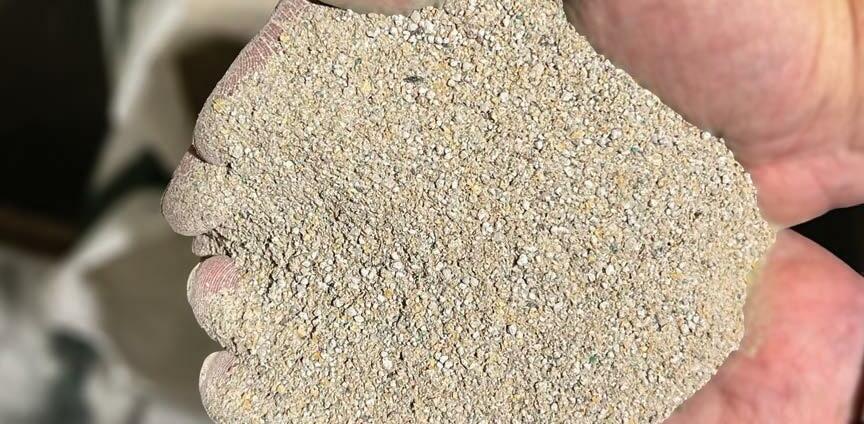
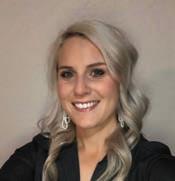
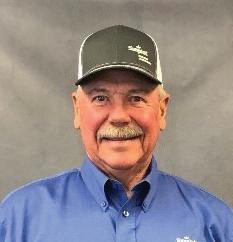

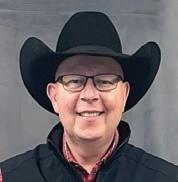
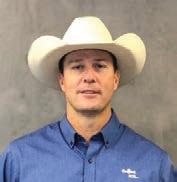
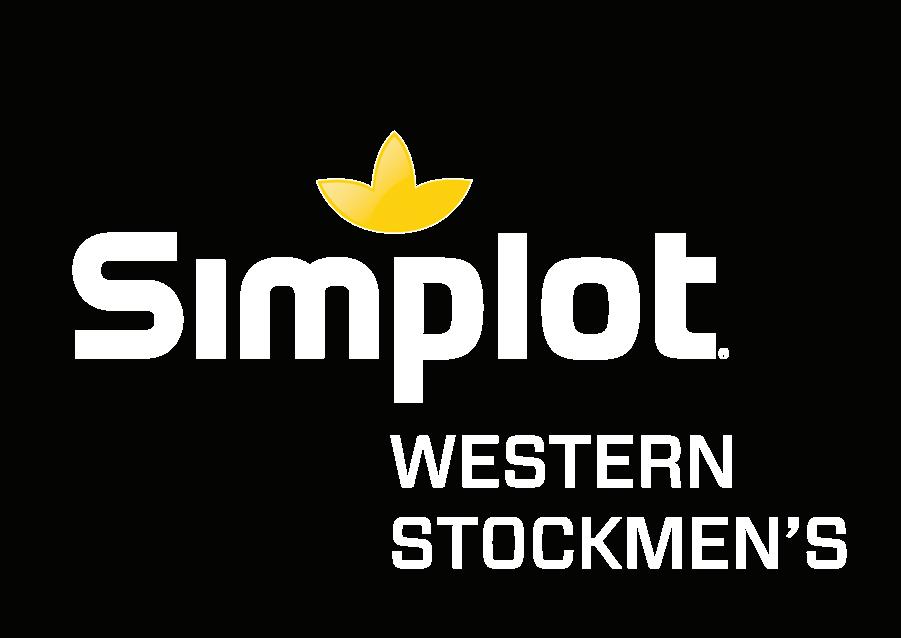
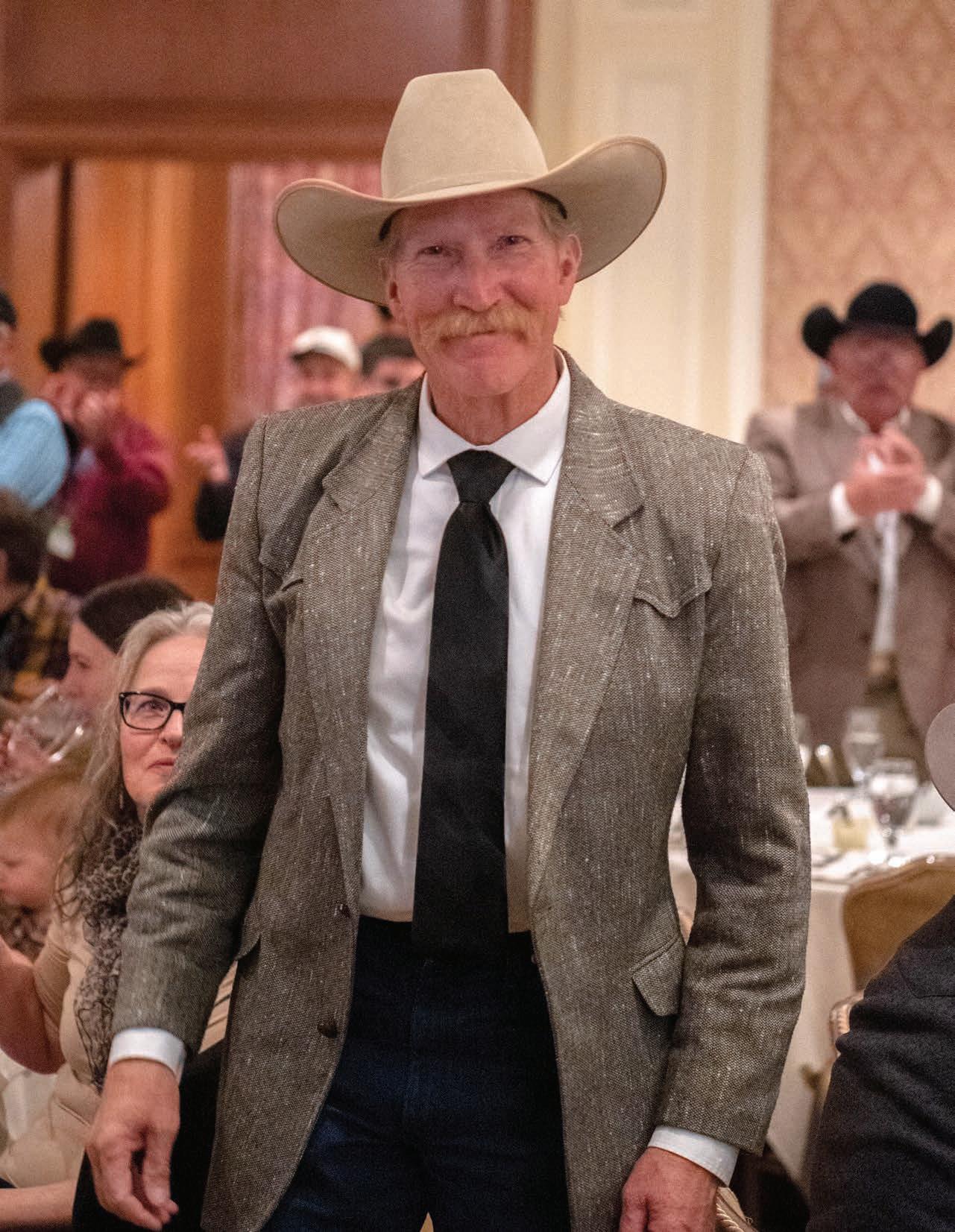
As in years past, the Idaho Cattle Association (ICA) was able to welcome student interns from 3 colleges to facilitate smooth convention operations and who also served as major contributors in the recap to follow here.
During recent months, we’ve highlighted some unique facets of the beef industry chain that serve a part in making Idaho a state that is, to a degree, self sufficient in the production of beef. While we’ve focused on feed sources and in-state packing facilities, this 3rd, and final, installment focuses on a variety of elements (which will be highlighted through a recap of our recent convention), that make Idaho unique : our people and ICA members.
ICA’s 2022 annual convention served as both an ‘end of the trail’ and ‘start to the ride’ signal for many. Members came from around the state, in near record numbers, left their operations for a few days to both reset and recharge while focusing on their individual businesses, as well as the statewide industry. During these few days, they spent time reviewing the prior year and preparing for the upcoming one through interactions with fellow producers and taking part in a variety of education sessions. This year’s convention not only saw growth in overall attendance, but a record setting year for students attending from Idaho schools – proving that the upcoming regime for the beef industry is ready to learn and take their place in Idaho’s ranks.
with contributions by : Aryiah Burnett, BYU Idaho Aubrey Rose, BYU Idaho Cadence Bass, CSI Kennedy Farden, CSI Mackenzie Malson, U of I Maggie Shaw, U of I
The opening session of ICA’s convention was presented by Hugh Aljoe, Director of Producer Relations for the Noble Research Institute. Aljoe championed the topic of soil health where he detailed this to be the basis of all farm & ranch operations, with 654 million acres of grazing land and pasture in the U.S. The 4 main grazing variables to consider when caring for the soil include timing, frequency, intensity, and duration, with frequency being the most important to ensure plant recovery. Aljoe emphasized the full circle of optimal performance with soil health at the root of all production success.
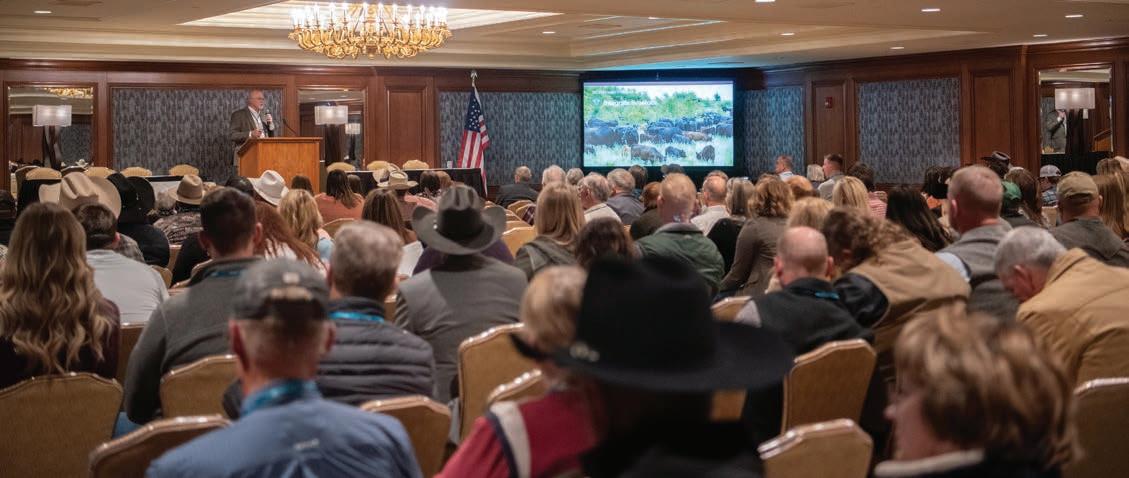
With the conclusion of midterm elections in the rearview mirror, this session relied on a panel of speakers in various roles of expertise, moderated by ICA outgoing President, Mark Pratt. Participants included former Representative Laurie Lickley, incoming Representative Jerald Raymond and re-elected Senator Van Burtenshaw. Pratt asked the panel for their opinions as to key issues the legislature will likely face in the upcoming session and response from the panel ranged from water & land to overall growth in the state to education. Additionally, panelists were asked about obstacles facing agriculture in state policy. In large, the response was that water mitigation, as well as allocation of funding available through JFAC, are the obstacles. Audience member Darren Parker, staffer for Senator Risch’s office asked the panel for their thoughts on the recently passed constitutional amendment that allows for the legislature to call themselves back into session, to which all answered with opposition.
Erica Hansen, of the Intermountain West Joint Venture started out the session for Partners in Action by talking about how important private lands are in conserving the wetland and mesic habitats of Idaho. (Wetland habitats are flooded at some point of the year while mesic habitats stay green late in the year, like sage brush). Wetland makes up only 1% of Idaho but houses around 75% of Idaho’s wildlife.
Hansen took the opportunity to describe the Wetland Evaluation Tool (WET) and how it is used to measure the amount of standing water in an area. If you would like to access the WET tool for Idaho, you can search “Idaho Beta Version WET.” After Hansen finished the first half of the session, Idaho Fish and Wildlife’s Jason Pyron took the stage to discuss about how disproportionately favorable private lands are to wildlife since wildlife “doesn’t care if the land is private or not.” Pyron then coverd how Fish & Game programs could provide technology and financial assistance to landowners who are interested in enhancing wildlife habitat, as well as offers funding year round to those who are interested in enhancing the habitat for better wildlife quality.
During the Cow-Calf and Purebred session of the ICA convention, Idaho State Veterinarian, Dr. Scott Leibsle, spoke to the membership about state-wide updates primarily surrounding Trichomoniasis. It was reported that Allflex signed a five year contract with Idaho vets to make sure everyone has plenty of Trich tags.
Among new updates were grazing permits needing to be
approved, along with producers being now required to run a PCR test on cattle if state lines are being crossed with cattle required to have an official form of identification. There are currently zero herds in quarantine for brucellosis, however the USDA is no longer supplying producers with free, metal bangs tags with the intention of incentivizing the industry to go electronic making it easier to monitor disease and overall numbers.
Additionally in this session, the University of Idaho discussed how it’s recent award of 55 million grant dollars can be put towards different aspects of agricultural industry. A large portion of the money will go towards marketing and teaching the public “the true story of ag.”
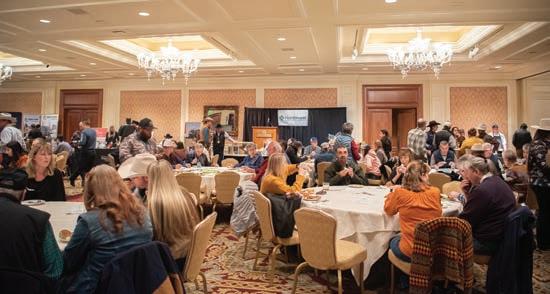
State Brand Inspector, Cody Burlile, brought updates on the state brand department. This last year was the largest inspection rate Idaho has had in over 20 years with an estimate of around 2.3 million head with only around 10,000 being horses. Along with high head numbers, expenses have also been steadily increasing, which could affect the total number of cattle in a negative way. The state branding inspection agency encouraged the members in attendance to give their thoughts and feedback. The session had no new resolutions and was adjourned.
State Brand Inspector, Cody Burlile, opened the session with an update for the July through June Fiscal year of the state brand department. Their records show that during this fiscal year, they inspected 2.3 million head of livestock, with less than 1% of that statistic being horses. This figure is 200,000 head away from reaching an all-time high. The influx in livestock being inspected is due to the drought and ever-increasing expenses associated with raising livestock. Expenses for the department are also increasing, as shown by the fact that they profited just $235,000 even during the 20 year high. According to Burlile, the department has an additional $200,000 in expenses this year. Due to this, the department is taking a proactive approach and starting conversations within the industry about these issues and potential solutions. While there are no fee increase at this time, Burl-
ile emphasized their proactive approach and that a fee increase could be possible within the near future.
Ethan Lane, Vice President of Government Affairs from the NCBA discussed the Waters of the United States Rule and PROP 12. The Supreme Court decision for both pieces of legislation is pending. For the Waters of the United States Rule, Lane referenced previous Supreme Court rulings such as West Virginia vs. EPA and the WOTUS Decision. The agriculture industry argues that there needs to be more of a focus on how long a body of water holds water, and how it is connected to the rest of the United States. He also discussed PROP 12, which would eliminate the use of gestation crates, greatly impacting the hog industry.
Dr. Scott Liebsle, Idaho State Vet, also addressed the session with an update concerning brucellosis and reported that in the past 3 ½ years, there have been no cattle under quarantine that have tested positive for this disease. There is 1 captive elk herd that has tested positive that is under quarantine and they are continuing to monitor and test. Dr. Liebsle assured attendees that due to their aggressive testing on cattle and enormous surveillance of the disease, producers can be confident that their herds are brucellosis free. Dr. Liebsle also discussed two updated rules; the Beef CAFO ruling and the Dead Animal Carcass and Disposal ruling. The USDA has also announced that funding for metal bangs tags is being redirected, with the industry transitioning to the use of EID tags, but the metal tags are still legal.
Three resolutions were also brought before the council:
1. Proposed Regulation of Fugitive Air Emissions
2. Nutrient management plan requirements for third party recipients
3. State commodity and feed lien law
The board recommended that all of these resolutions be renewed, and the council reaffirmed all of these resolutions.
Valene Cauhorn gave an update of the CAFO improvement fund. Last year, $5M was allocated to fund 13 projects, and there was over $52M requested. She discussed how to keep beef at the table, as only two of the 13 projects were beef related, with the others being dairy. She shared that a producer needs to clearly
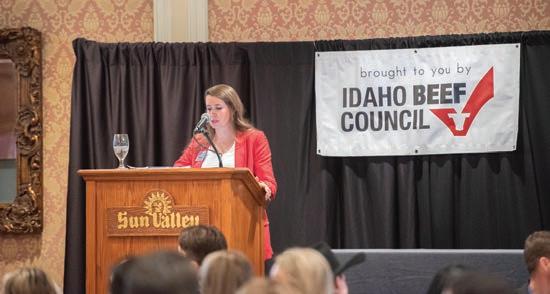
show their current situation and show how the funding would help them improve, as well as how it improves the environment.
This year’s Cattlemen’s College focused mainly on genetics & vaccines, with speakers Dr. Kent Andersen and Dr. John Hoehn Pollreisz. Utilizing genetic programs can help give
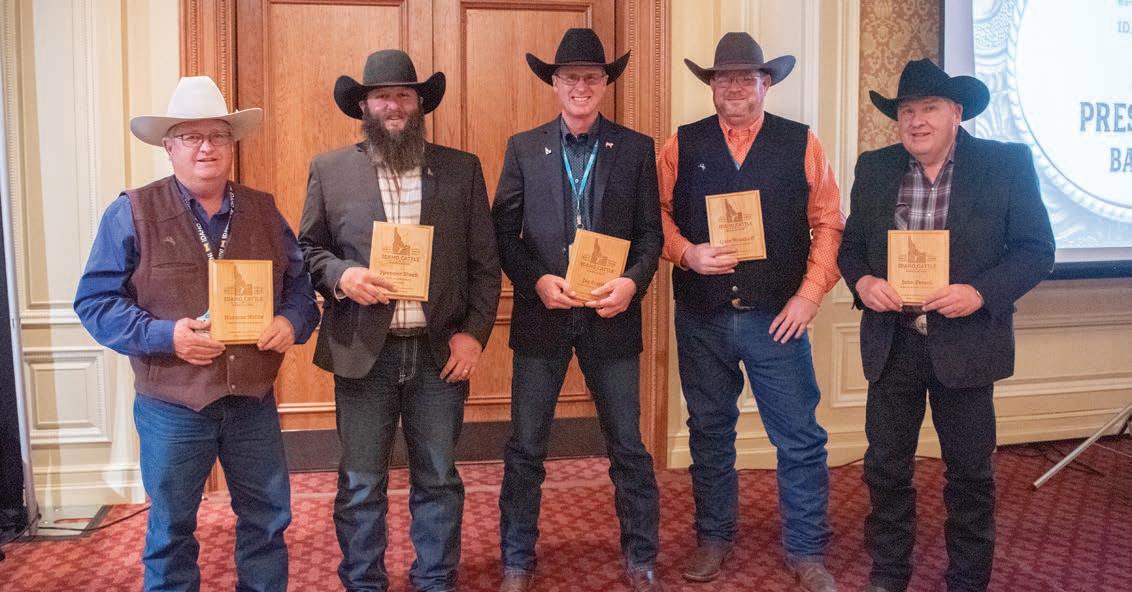
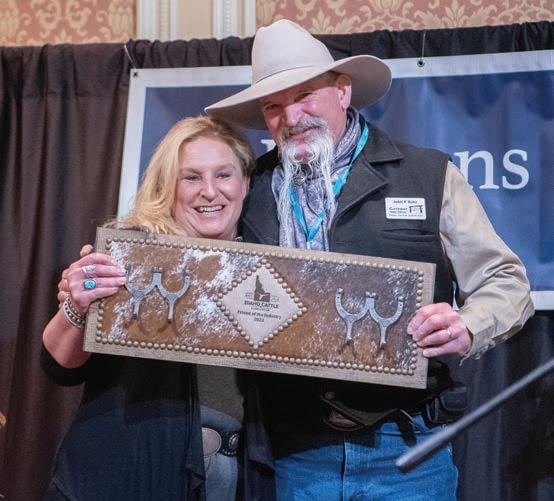
detailed EPDs from tissue samples and such programs are designed to help you steer clear of troublemakers, as well as identify market potential. Dr. Pollreisz discussed vaccine response with sick animals, as well as optimal delivery system & timing for successful vaccine programs.
Ethan Lane delivered the Tuesday morning address surrounding a more national outlook for the beef industry. Lane charged attendees to take action by discussing what it is that can be changed and not continue to stay silent on the issues at hand. Lane shared that many people are misinformed about agriculture and that ICA members should continue to educate themselves on the political needs for the beef industry. This includes supporting political figures who are adept at stopping the spread of false information surrounding the cattle industry, as well as continuing to share feedback.
Lane updated attendees on true cost of the farm bill increasing from 800 billion dollars to 1 trillion dollars, due to inflation. Additionally, there are many bills that affect certain parts of agriculture, for example horses not being able to be transferred to slaughter. This isn’t something that is currently happening to the cattle industry, but it is something that could eventually cause impact


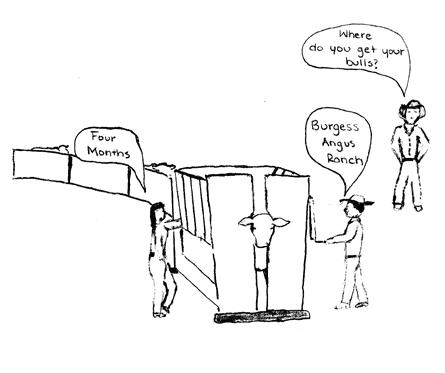
if action isn’t taken proactively. The change in climate is blamed on cattle, when, in reality cattle are a reason America has the lowest air pollution in the nation. The media makes cows seem terrible and that is something members should strive to change.
Lane ended the session with the incitement that not only does the cattle industry need support, but this is our future and without cows and farms the world won’t go round.
Wade Small, Executive Vice President of Business Development for Agri Beef, and Jay Theiler, Executive Vice President of Corporate Affairs for Agri Beef, addressed the convention with updates surrounding True West Beef’s packing plant in Jerome, Idaho. Small analyzed the packing industry as a whole and the supply in the western United States, while Theiler spoke to the vision of True West.
Highlighted by Small were fluctuation to changes in capacity which resulted in plant closures at Tyson in Boise, ID (2006) and National Beef in Brawley, CA (2014), as well as added capacity at One World Beef in Brawley, CA (2016) and CS Beef in Kuna, ID (2017).Currently there are 86 total FSIS Beef processing facilities operating in the western United States, with 59 of those being “very small” ( <10 employees), 18 being “small” (10-350 employees), and 9 “large” (> 350 employees). Small also discussed the effects of COVID on processing, with small sized plants experiencing a large increase in margins due to the high demand of custom cutting & new branded programs. He also addressed the issues of limited cattle supply, the drought and limited feed supply, the increase in operating costs, and the effects that Canada and Mexico have on the packing industry in the western United States.
Jay Theiler presented the vision of True West to the
convention. Of the 40 large packing plants throughout the United States, there are only 2 in the Northwest, located in Hyrum, UT and Toppenish, WA. These two plants are over 650 miles apart. Due to this, Agri Beef decided to embark on the True West Beef plant project. This new facility will service a large geographical area and increase industry capacity in the state. True West Beef is unique in that it is a partnership between Agri Beef and a network of 25 cow-calf and cattle feeding producers. This collaboration was done with a strategy in mind to enhance the value of the end beef product. They plan to begin operations at the end of the first quarter starting at 500 head per day, with the potential to easily increase to 750 head per day. The plant is also equipped to process the byproducts associated with processing beef, including tallow and meat & bone meal. Theiler emphasized the impact that this new facility will have on the community, as well as how the company plans to give back.
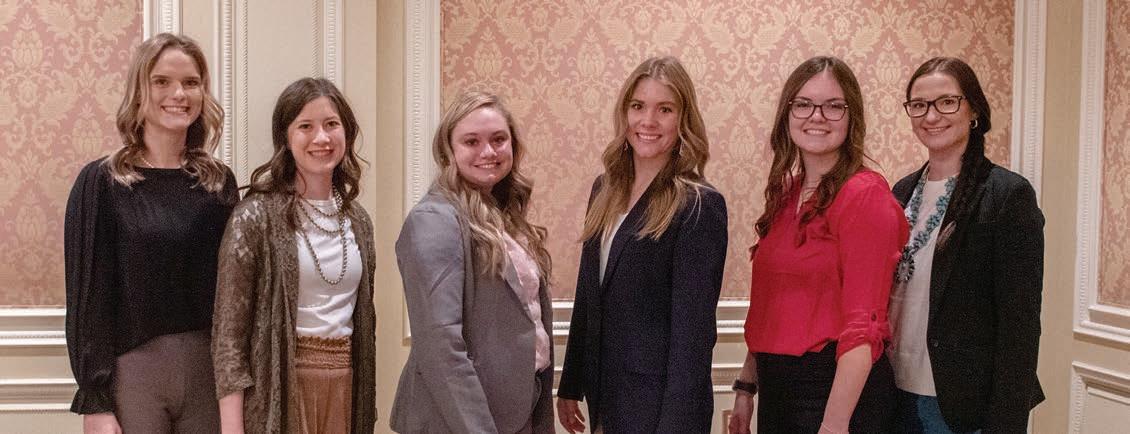
Highlights from the Idaho Beef Council (IBC) Luncheon included Beef Counts, the Nourish Idaho program and the Explore Idaho program. The Nourish Idaho program was a way to connect new people moving into the state to the cattle industry, while Explore Idaho served as a mini ‘pasture to plate’, in an effort to educate Idahoans on the process of how their beef is produced.
Emma Mulvaney, Associate Director of the Beef Quality Assurance (BQA) program, offered information on how Idahoans perceive the cattle industry. Highlights included that 43% of Idahoans feel uneducated about the beef industry, but 39% of Idahoans see the cattle industry in a positive way, and animal welfare is a top concern for consumers throughout the nation. The BQA program
helps give consumers confidence that the animals are being treated humanely. Consumers also love to see the connection between ranch families, the cattle they raise, and what ends up on their plate. The program ‘Beef. It’s what’s for Dinner.’ has helped improve consumer confidence and gained more positivity toward the industry. For more information visit www.beefitswhatsfordinner.com.
While the IBC held a BQA certification following the convention in Sun Valley, it’s worth noting that the trainings to become BQA/BQAT certified are available in person and online. The purpose of the BQA program is to do things the right way, and it is for everyone, not just producers. We want consumers to view beef in a positive way – visit www.Idahobeefquality. com to get certified or see a list of upcoming trainings.

Dr. Boone Carter, staff vet at Performix Nutrition, spoke on “Making Cost Efficient Feed Decisions.” He began by defining efficiency as output per $ of feed input. Main points were feed value and feed utilization, with the goal of decreasing feed cost. Dr. Carter highlighted 4 main limiting factors holding back cattle from utilizing their feed : intake (such as moisture and roughages), equip -
ment, toxins, and nutrient limitations. He also discussed key things a mother cow needs such as water, carbs, protein, macro minerals, micro minerals, and vitamins.
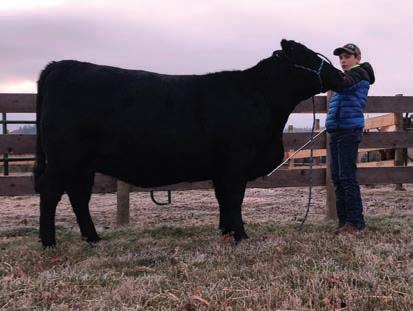
Dr. Carter broke down the numbers to conclude alfalfa is 30% more efficient as a roughage. He then compared equipment: truck, E-Z Feeder, or mixer wagon, with the truck was the clear winner. Then Dr. Carter compared combinations of flake hay: the E-Z feeder with 50:50 versus the mixer wagon with 25:75, making the mixer the most efficient.. He explained that things may look cheaper from the outside but it is important to break it down and do the full work to understand what is best for your operation.
While one way may work for one operation it may not work for another so it is very important to consider geography, labor requirements, facility limitations, and other uses for equipment. It is important to factor in all of these limitations and do the right thing for your operation.
Then moving to feed utilization, Dr. Carter spoke to the fact that feed waste is most important to consider. Those who feed on bare ground have 15-25% waste and on snow no less than 10%. Bunks and feeders pay for themselves and are a wise investment. To increase digestibility, processing forage (grinding/chopping) is an efficient way to lower your feed waste. Feed additives such as ionophores, yeast extract, and live probiotics can also increase digestibility in turn making the cattle more efficient.
Keynote speaker Hugh Aljoe, built off of his opening address to connect and breakdown 10 common questions/myths in regards to regenerative ranching. This session included a variety of highly interactive opportunities, with myths addressed ranging from ‘animal performance is sacrificed for land stewardship’ to ‘one cannot use fertilizer or chemicals in regenerative ranching’!
Public Lands Council President Mark Roeber kicked off this breakout session with updates about the council and encouragement to get involved through submission of public comment opportunities. Kaitlynn Glover, Executive Director of the Public Lands Council, highlighted the four key areas of regulatory, legislative, judicial, and the public that the Council engages in. Related to the regulatory field, Glover discussed President Biden’s 30

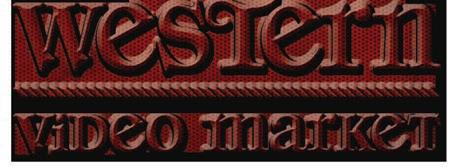
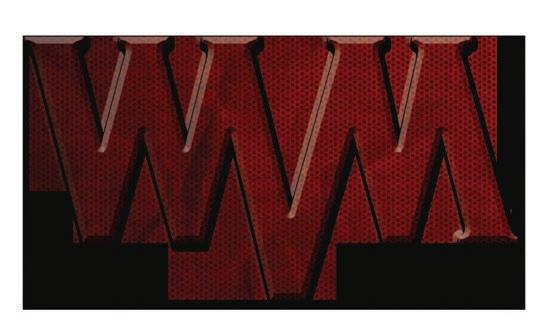
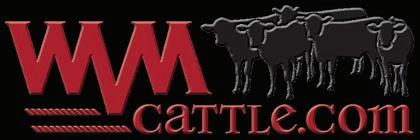

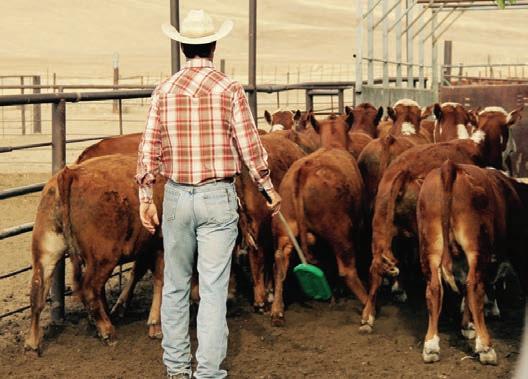

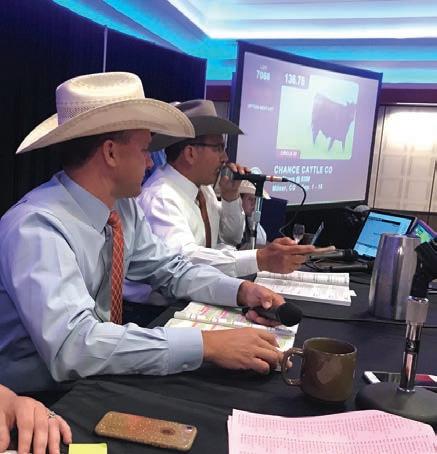



by 30 plan. She said a “menu” of sorts would be available for states and agencies to choose from, once it comes to implementing the new rules regarding reclaiming land and should be released near year’s end.
Glover also discussed how the Idaho delegation is legislatively in the right places for national resources and also made the point that the USDA/Agencies cannot praise private land stewardship and then penalize the same actions on government land. In regards to Judicial matters, Glover discussed how the Public Lands Council is involved in the current cases relating to Lower 48 wolf delisting, as well as watching the challeng-
ing of three ESA rules from the Trump Administration. Glover also emphasized that when discussing the public perspective of public lands, it is important to talk to people, whether it’s the polling line, meat counter, or on the public lands themselves. Creating more advocates is important because apathy is growing and can pose threats to the grazing communities if other groups reach the apathetic crowd first.
Also at the session, Karen Kelleher, the director of the Idaho Bureau of Land Management, shared that Idaho BLM has treated 300,000 acres this year in the form of weed treatments, fire breaks, or seeding as examples. 1.5 million acres
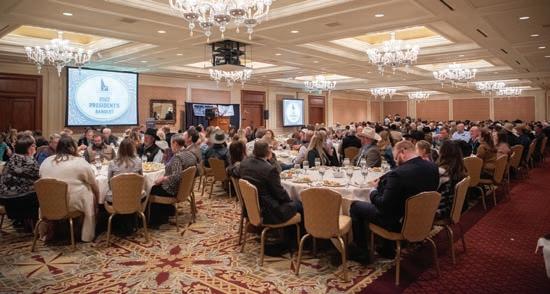
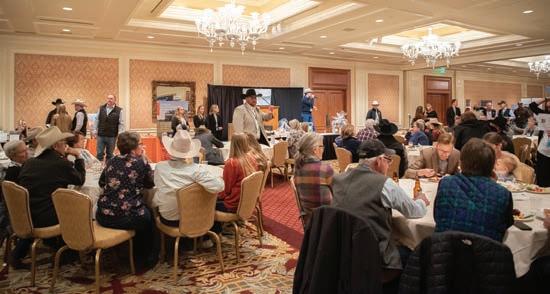
are hoped to be treated within the next 5 years. Kelleher’s perspective was that 2022 was a relatively ‘good’ fire year for the BLM in Idaho, with most fires this year occurring on forest ground.






Dr. John Hall began the session with an update on happenings at the Nancy M. Cummings Research Center, sharing that it conducts a spectrum of cattle research, ranging from feedlot cattle, range cattle, and even registered Angus cattle. They are able to supervise research in genotype and phenotypes in cattle, which allows for a closer look at the genetic makeup of the cattle. Additionally, the research center has studies on range cattle and their effectiveness when it comes to eating and producing, as well as working with sexed semen and artificially inseminat-
ing (AI) cattle. The ranch has a current study in session that deals with cross breeding. The crossbreeding entails black angus cattle and Hereford cattle crosses. They have found that through this, they have seen an increase in carcass size in the calf crop.

Also during the session, Meat Sciences graduate student Sierra Jepsen performed a live demonstration on how to properly cut a ribeye. She also elaborated on reasons for why a ribeye can’t always be sold as is, including serving size, and how to mitigate this through cutting in half to make for a more enjoyable eating experience and reduce waste.
ICA’s Annual Convention President’s Banquet served as a roast and time to honor 2022 President Mark Pratt’s service to the industry, as well as issue a welcome to incoming President, Kim Brackett. Attendees enjoyed the now famous Prime Rib banquet and celebrated outgoing ICA Board members, whose terms have concluded. These board members included Past President Jay Smith, District 1 Quin Wemhoff, District 2 Marg Chipman, District 3 John Peters, and District 4 Norman Wallis. Additionally, special awards were made to John Ruhs as the 2022 ICA Friend of the Industry and former Senator Carl Crabtree as the 2022 Beef Industry Leader.
The final session of the 2022 ICA Convention was presented by John Nalivka and Brett Stuart. Both speakers dove into American and world economics and predictions for 2023. Nalivka started the session by talking about how the current drought has affected the economy and cattle market, in the sense that drought decreases the number of live cattle being raised but
increasing the number of slaughtered cattle since grass is too low to feed a large amount of live cattle. Operating costs are also sharply increasing due to drought, while slaughter is down for dairy cattle and steers but is up for weekly numbers and heifers.
Speaker Brett Stuart dove more into global beef markets. He discussed inflation, which is currently at 9.6% in the United States. COVID has increased the money supply of the world by +44% in the last two years. This makes interest rates higher and increases the dollar “value” which makes export harder and more expensive. The U.S. beef industry is at an all-time high with exports, mostly going to China (Hong Kong) after the ”Phase One: China” export deal.
As you can see, throughout the convention attendees listened in on sessions intended to continue strengthening the Idaho beef industry. From sessions geared toward engaging our students (with a record setting 70+ students at this year’s convention) as the next generation, updating resolutions with our membership and providing a future forward lens on research and politics, this convention tied together the elements that solidify Idaho as a beef industry leader. ‘Independent Idaho’ isn’t just a term, it’s a reality for our state. While we aren’t exempt from issues on a national scale, we do have the power to make changes at the state level that binds us together in ways other cattle producing states will never see. If you’ve never taken the time to consider membership or attendance at an ICA event, maybe 2023 is the year you do things a little differently. Our next issue will introduce leadership, as well as review association priorities, which are dictated by our member led Board of Directors. Remember, the way to keep Independent Idaho beef chain ‘independent’ is you!
*If you’d like more information on any of the sessions or have questions, please contact the ICA office.
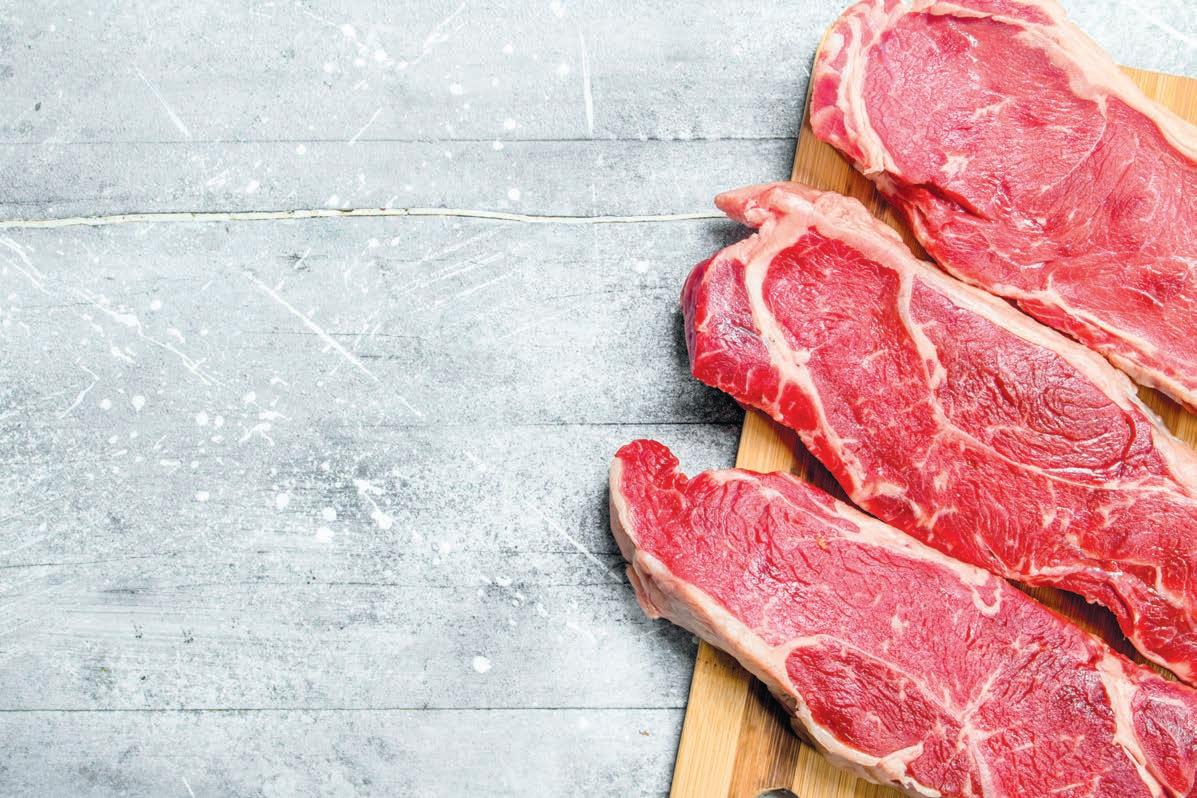



As you reach into your freezer or refrigerator grabbing a package of beef, how many times have you counted your blessings for being able to nourish your family with a safe, wholesome, delicious, high-quality protein that you raised? Now imagine… not having a freezer or food in your home to feed your family. According to The Idaho Foodbank, nearly 9 percent of Idahoans are food insecure. The U.S. Department of Agriculture defines food insecurity as a lack of consistent access to enough food for an active, healthy life.
Beef Counts for hungry Idahoans. Karen Vauk, CEO and President at The Idaho Foodbank, has mentioned that food donations are received and much appreciated. However, not all of them pack the nutritional punch of beef that recipients need:

• Protein – a key foundational nutrient for supporting strength and plays an important role in building muscle
• Iron – an essential nutrient for both
the function and growth of your body
• Zinc – supporting a healthy immune system
• Selenium – an essential component of at least 25 unique compounds that have a big impact on proper immune, thyroid, cardiovascular and digestive function
• Vitamin B6 – influences cognitive development
• Niacin – promotes healthy skin, nerves and digestive tract
• Riboflavin – supports normal vision and healthy skin
• Vitamin B12 – supports the developing brains of young children
• Choline – needed by the brain and nervous system to regulate memory, mood, muscle control, and other functions.
• Phosphorus – makes up 1% of a person’s body weight and its main function is formation of bones and teeth.
Through the Beef Counts program, over 1,750,000 servings of nutritious, delicious beef have been provided to feed thousands of children, families and senior citizens throughout Idaho who go undernourished and underfed each month.
Beef Counts in building stronger communities. The Idaho Beef Council, Idaho Cattle Association, Idaho CattleWomen Council and Agri Beef Co. joined forces to establish the Beef Counts program to Give Hunger the Boot, nourish Idaho and build stronger communities. Celebrating its twelfth


anniversary, the Beef Counts program not only provides awareness about beef nutrition and the need for a high-quality protein through The Idaho Foodbank, but it also showcases the importance of Idaho’s second largest agricultural industry – beef!
Trish Dowton, Idaho beef producer, summed it up well!
“The Beef Counts program is a great way to give back to the community. As a rancher, I believe strongly in the quality and commitment that goes into producing beef and beef products in this state. As a good neighbor, I and other ranchers want to make sure that all Idahoans have access to the nutrient-dense protein of our beef.”
Beef Counts in giving hunger the boot!
There are several ways you can become involved to build the Beef Counts program:
• Donate now and double your investment! Agri Beef Co.
will generously match the first $50,000 of donations received!
• Volunteer to distribute beef in your local communities through mobile distributions.


• Volunteer to label beef roasts and ground beef chubs at The Idaho Foodbank.

• Distribute Beef Counts sponsorship packets to businesses in your local community, build awareness and encourage support for the program.
• Host community fundraisers benefiting the Beef Counts program!
• Contact the Idaho Beef Council at 208-376-6004 or BeefCouncil@IDBeef.org for Beef Counts questions, information, ideas and partnerships.
• Visit www.idbeef.org/raising-beef/beef-counts for latest Beef Counts information and opportunities.
You know how to raise them. We know how to sell them. We’ve been working for cattlemen like you since 1987. Consign in an upcoming video auction to take advantage of current market conditions and expose your cattle to a nationwide buyer base of more than 6,500 active buyers ready to compete for your cattle. This gives you the opportunity to utilize the auction method of marketing, while maintaining control of shrink and stress, helping to improve your bottom line.


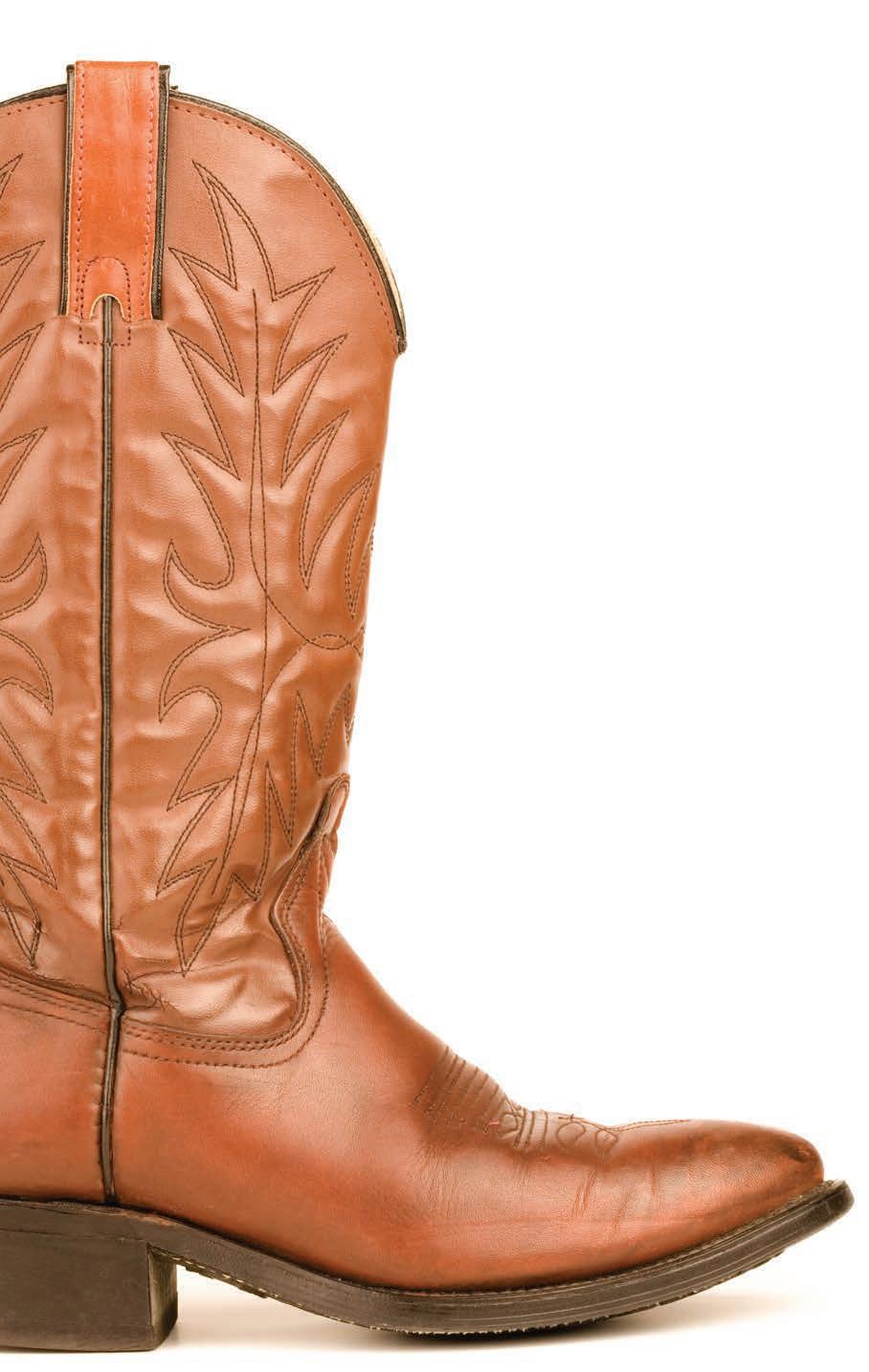

Most beef producers are weaning calves and making selection decisions on replacement heifers this time of year. Sometimes it can be difficult to find the time to make the best selection decisions with everything else that is going on, and when there are not enough hours in the day, it is easy to select heifers on shipping day based on how they look and what you can remember about their mother. We have all been guilty of doing just that on occasion, but that selection method by itself does not always work when you are trying to make genetic improvements in your cow herd. Sure, you do not want to keep the bag-of-bones with the potbelly regardless of their genetics, but the key to making the best decision is having and referring to good records and supplementing those selection decisions with conformation and demeanor. Sitting down with your records spread out in front of you can help speed up the decision-making process and ensure that you are choosing the correct heifers to retain in your herd.
Genetic progress is not just made through bull selection. As you bring replacement heifers into your herd, remember that the bull only throws half of the offspring’s genetics, and the cows are responsible for the other half. Take some time to think about what would really benefit your herd, whether it is better growth, better mothering ability, or better performance on range. Selection can be as simple as choosing one or two traits to select for or using several traits in an index.

• Single Trait Selection: Select the top performing heifers for one trait.
• 2 or 3 Trait Selection: Select heifers that perform above a specific threshold for both/all traits OR select the top performing heifers in one trait, and then from that group, select the top performing heifer in the second trait (this method works well for selection for the first trait at one time period, and then selection for the other trait at
a later date; for example, trait 1: weaning weight, trait 2: yearling weight).
• Index Selection: Select for multiple traits using a weighted index. This method allows you to choose how important each trait is to the selection. For example, you may want to have one trait make up 60% of the decision, the second trait make up 15% of the decision, the third trait make up 10%:
Index Value = (0.6 x Trait 1) + (0.15 x Trait 2) + (0.10 x Trait 3)
Another way to weight the index is to put dollar values on each trait. For example, each pound of weaning weight may be worth $1.90, and you may estimate that it costs you $0.50 in labor for each pound of birth weight above 80 pounds. These values can also be incorporated into the index as a weighted value:
Index Value = ($1.90 x lb Weaning Weight) + ($0.50 x lb Birth Weight above 80 lb) + ($ x Trait 3)
As long as you calculate the index the same for each heifer,
you will be able to select the best performing animals with the highest index values. Personally, I use an Excel spreadsheet to do the math for me!
Maybe you are most interested in improving weaning weight, but to do this, you will need individual weaning weights on each of your heifers. Additionally, if you do have the capability to weigh each animal at weaning, do not forget to account for differences in age and birth weight. Selecting your biggest heifers does not necessarily mean you are getting your best growing heifers (see Figure 1, for example). Often, body weight at weaning reflects age more so than it does gaining ability. Assigning heifers into categories, such as ‘small’, ‘medium’, or ‘large’, when you do not have a scale for measuring individual body weights can also be an effective selection tool.
Figure 1. Heifer calves born in March/April and weaned on October 15.
Heifer ID Birth Weight Weaning Weight Age at Weaning Average Daily Gain
001 90 lb545 lb195 days2.3 lb
002 70 lb497 lb180 days2.4 lb
003 65 lb512 lb172 days2.6 lb
Quality growth genetics are only so good in a range cow herd. It is important to look back in the records to make sure you are not keeping heifers from a line of cows that fall out of the herd by age 4, do not bring a calf home from range half of the time, bring home a small, dinky calf at weaning every year, or have calving problems every year. For a range herd, it is important to have lines of cows that are hardy on range, bring home a big, healthy calf each fall, breed back quickly, stay in the herd to a ripe old age, have no calving problems, and have good milking ability (but not too much).
These are some simple methods that you can add to improve your replacement heifer selection decisions and make bigger strides in genetic improvements in your herd. Identifying where you can improve your herd genetics and keeping a good set of records can make all the difference in your selection program. Often you can make selection decisions based on individual performance (such as weaning weight) and then weed out poor cow lines by checking each heifer’s maternal line records and assessing her physical conformation. Remember, your county or statewide UI Extension educators are always happy to assist in this important decision-making process!

The State Animal Damage Control (ADC) Board was established in 1951 to prevent and control damage caused by predatory animals and other vertebrate pests to agriculture production in Idaho. Monies received by the ADC Board pays for the control of coyotes, jackrabbits, skunks, weasels, starlings, raccoons, lions, bears, and pelicans. The State ADC Board is made up of nine individuals: Chairperson of the Idaho Sheep and Goat Health Board: Steve Wilder, Appointee by the Idaho Cattle Association President: Cameron Mulrony, The Director of the Idaho State Department of Agriculture: Celia Gould, the Director of the Idaho Department of Fish and Game: Ed Schriever, and the chairperson from each of the five ADC Districts: Bill Rickabaugh, ADC District 1; Phil Davis, ADC District 2; John Noh, ADC District 3; ADC District 4 is vacant; and Jeff Siddoway, ADC District 5. The Idaho Sheep and Goat Health Board provides administrative services to the State and District ADC Boards through their Executive Secretary, Emily Merrigan.
Each county is represented on a District ADC Board by one agricultural producer. That producer is appointed by their local county commissioners after being formally nominated by a livestock or agriculturally oriented group and serves a two year term.
The 44 counties are divided into the five ADC Districts as follows:
District 1: Benewah, Bonner, Boundary, Clearwater, Idaho, Kootenai, Latah, Lewis, Nez Perce, and Shoshone
District 2: Ada, Adams, Boise, Canyon, Elmore, Gem, Owyhee, Payette, Valley, and Washington
District 3: Blaine, Camas, Cassia, Gooding, Jerome, Lincoln, Minidoka, and Twin Falls
District 4: Bannock, Bear Lake, Bingham, Caribou, Franklin, Oneida, and Power
District 5: Bonneville, Butte, Clark, Custer, Fremont, Jefferson, Lemhi, Madison, and Teton
Each District ADC Board holds annual meetings where they sign an agreement paying for the control of coyotes, jackrabbits, skunks, weasels, starlings, and raccoons. Those agreements cover agricultural producers who contribute to the ADC
districts through brand, wool, and/or grazing assessments. Currently, all five ADC Districts maintain that annual agreement with USDA Wildlife Services.
Contact USDA Wildlife Services at 208-373-1630 to reach your local Wildlife Specialist
USDA Wildlife Services has numerous Wildlife Specialists, commonly known as ‘Government Trappers’, spread across the state. To find your local Wildlife Specialist, contact the USDA Wildlife Services office at (208) 373-1630. Mention this article and ask for your Wildlife Specialists name and contact information. It is important as a producer to establish and maintain a relationship with your local Wildlife Specialist so you can work together efficiently to protect your farm or ranch.

The State ADC Board holds two agreements with USDA Wild-
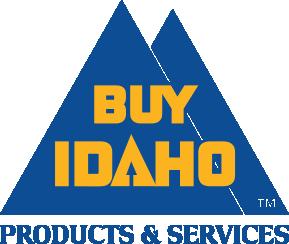
life Services, one for the control of lions and bears, the second for the control of pelicans in specific areas identified by the Idaho Department of Fish and Game (IDFG). These agreements enable producers to request assistance from USDA Wildlife Services to prevent and control damage caused by lions and bears and are solely funded through the IDFG. To request services with these animals, contact your local Wildlife Specialist.
The State and District ADC funds are all managed by the Executive Secretary and reported to each Board regularly. To fund the financial agreements, the State and District ADC Boards collect money from several avenues.
sources are split fairly amongst the five districts, as decided by the State ADC Board. Also included in that single check is money from the IDFG. Of the IDFG dollars, half are split equally between the five ADC Districts, and the other half is split equally between the lion/bear and pelican funds.
The five District ADC Boards also request annual contributions from the counties within their District. Of the 44 counties solicited, 38 regularly contribute funds. The amounts given by each county vary based on the amount of service needed and available dollars. It is the responsibility of the county representative on each District ADC Board to converse annually with the local commissioners to ensure the county is contributing to the District. Grazing districts across the state also contribute to their local ADC District annually. Those funds are split to correspond with the District each grazing allotment is a part of.
Each year, dollars are allocated across all parts of Idaho government. The allocation designated for the ADC Boards is sent to the Idaho Sheep Commission, then forwarded to the ADC office as a check. That check includes the general allocation, brand money, and wool money. Those three income
The mission of USDA APHIS Wildlife Services is to provide Federal leadership and expertise to resolve wildlife conflicts to allow people and wildlife to coexist. To accomplish this, they maintain agreements with many different groups, covering a wide variety of wildlife. If you experience conflicts with any wildlife species, contact your USDA Wildlife Specialist and they will likely be able to assist.

333 Ranch LLC
Alder Creek Ranch
Allison Hubler
Amie Halstead
Andrew Barnard

Angel Arteaga
Bar Eleven Ranch
Bedke Ranch
Beyeler Ranches LLC
Bill Barton, DVM
Box Dot Ranches
Braylee Harwood
Broken Circle Cattle Co.
Cadence Bass
Charleston Heiner
Chris & Sara Kirby
Chris Macaw
Cody Coates
Colby Barry
Cole Lickley
Courtney Beene
Courtney Conley
CowBos
Dallan Johnson
Dennis Peters

Devil Creek Ranch Inc.
Double C Ranch
Double L Livestock, LLC
Eagle Valley Ranch, LLC

Ethan Gomes
Fern Ridge Herefords
Ford Ranch Inc.
Four Corners Land & Livestock
Grace Ertel
Hailey Chambers
Haley Hancock
Heckman Ranches
Howard & Zella Cutler
Isabella Mickelsen
Jason Bean
Jesse & Shae Human
Jim and Jan Little
Josie Williams
Josune Jaca

JT Albin
Kashli Stouard
Kate Kallenbach
Kathryn Mink
Ken & Roberta
Forsmann
Kiana Wilde
Kirk & Sherry Southern Kort Skinner
Lewiston Livestock Market
Lierman Land & Cattle
Lightning D Cattle Company
Mattie Merritt
Mulkey Ranch
Olsen Cattle Co.
P Bar Ranch, LLC
Pat Hawkins
Peyton Jo Cassinelli
Rance Butler
Silver Sage Ranch LLC
Sophia Cori
Sustainable Meat LLV

Sutton Livestock Co Inc.


Synovia Bates
Tate Morrissey
Taylor Dixon
Tim & Laurie Munns
Tristan Cassinelli
Westerra Real Estate
Whittaker Two Dot Ranch LLC
Woodrow W. Butler Family Trust

